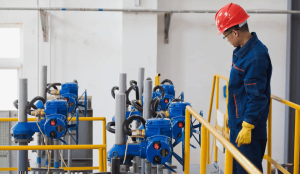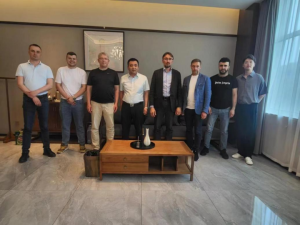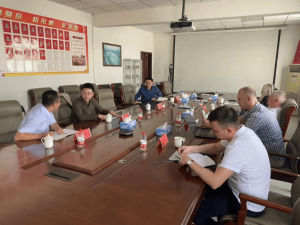On July 20, 2022, the China Methanol Industry Conference was held in Jinan, Shandong. Industry leaders including Gu Zongqin, Chairman of the China Nitrogen Fertilizer Industry Association, Zhang Jincheng, President of the Shandong Fertilizer and Coal Chemical Industry Association, Zhang Jinqiao, Deputy General Manager of Jinneng Holding Equipment Manufacturing Group, and Sun Zhitian, President of Mingquan Group Co., Ltd., attended the event. The conference was chaired by Wang Liqing, Secretary General of the China Nitrogen Fertilizer Industry Association.
Keynote Address
Chairman Gu Zongqin delivered a keynote speech titled “Energy Conservation, Carbon Reduction, and Market Expansion: Striving for Breakthroughs in Methanol Industry Development.” Gu highlighted the current global economic slowdown, deep adjustments in the international economic landscape, and the compounded impacts of U.S.-China trade tensions, the Russia-Ukraine conflict, and the prolonged COVID-19 pandemic. These factors have created significant uncertainty, posing broad and severe challenges to China’s economic development.
Gu proposed that the methanol industry should align closely with national policies, build on its current advantages, and focus on five key areas to achieve high-quality development:
1. Rational Industrial Planning
Gu emphasized the importance of scientific planning and optimized capacity management. While most chemical products have experienced record-high prices and profits, methanol has struggled with stagnant market prices. This disparity, including the price gap of over 1,000 RMB/ton between methanol and liquid ammonia, stems from overcapacity and excessive supply.
Gu warned that further expansion of methanol production without strong downstream demand will exacerbate market competition. He called for cautious planning and construction of methanol projects, considering resources, environmental impacts, and market dynamics to avoid blind investments.
2. Promoting Energy Conservation and Carbon Reduction
Gu stressed that achieving China’s dual carbon goals is a national strategy, requiring contributions from the methanol industry. Given that coal remains the primary raw material for methanol, Gu proposed adopting advanced production, environmental, and energy-saving technologies to implement effective upgrades.
Key focus areas for energy conservation and carbon reduction include:
- Increasing the use of green, low-carbon energy sources in methanol production to reduce reliance on coal. Policies should allow natural gas as a feedstock in resource-rich regions.
- Developing and demonstrating green, low-carbon process technologies, such as dry coal powder gasification at pressures above 6.5 MPa, optimizing waste heat recovery systems, and improving thermal efficiency in gasification units.
- Accelerating the application of efficient technologies, including syngas purification, isothermal carbon monoxide conversion, energy-saving methanol distillation, and advanced compression equipment.
Gu also highlighted the association’s efforts to revise national energy consumption standards for methanol, using standards to guide low-carbon development in the industry.
3. Expanding Downstream Methanol Markets
Methanol primarily serves as a raw material for low-value-added products. Gu urged companies to seize opportunities in high-value sectors such as coal-based epoxy resins, high-performance polypropylene, polyethylene films, and biodegradable plastics.
In clean energy, methanol fuel has made significant advancements in cooking, heating, and transportation applications. The inclusion of methanol-powered ships in the Ministry of Transport’s 14th Five-Year Plan for Green Transportation Development signals growing recognition of methanol as a clean fuel. Gu called for policies, technical standards, and market systems to support the healthy growth of methanol as a fuel.
4. Innovation as a Driving Force
Gu identified technological innovation as the cornerstone of high-quality development. For the coal-based methanol industry, innovation is essential for achieving high-end, diversified, and low-carbon transformation.
Priorities include:
- Tackling core technological challenges in areas such as ultra-large, energy-efficient coal gasification furnaces and the development of efficient purification and synthesis catalysts.
- Deepening the integration of production technologies with digital tools to enhance efficiency and operational management.
Focusing on disruptive technologies like stable and economical green hydrogen production and innovative CO₂ utilization methods.
5. Strengthening Safety and Environmental Protections
Gu addressed recent chemical industry accidents, emphasizing the need for robust safety and environmental management. He urged companies to implement the State Council’s Fifteen Measures for Strengthening Safety Responsibilities and conduct thorough self-assessments of risks.
By proactively addressing safety and environmental challenges, the methanol industry can ensure stable operations while meeting regulatory requirements.
Conclusion
The 2022 China Methanol Industry Conference provided critical insights and strategic guidance for the methanol industry’s future. By focusing on rational planning, energy efficiency, market expansion, innovation, and safety, the industry aims to achieve sustainable and high-quality growth in a rapidly changing global landscape.







